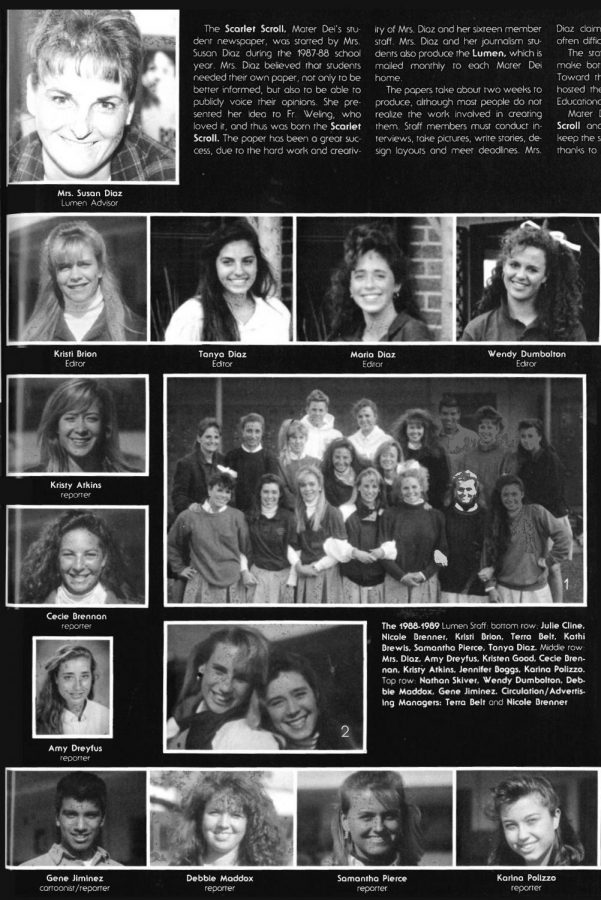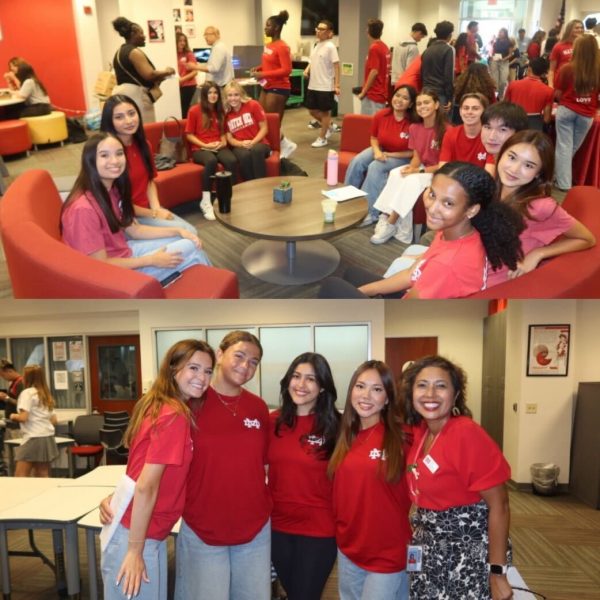The History of the Scarlet Scroll
From stories to photojournalism to comic strips, The Scarlet Scroll is the only student newspaper of Mater Dei. But, despite its unique position on campus, its history is largely unknown to the school and even the publications staff. So the hunt was on to figure out the long and complex history of the paper – and all good stories start at the beginning.
Mater Dei High School was founded in 1950. Not long after that, in the 1954-55 school year, the journalism class teacher Sister Mary Paul, S.S.L., began a publication called the “Hi-Lighter.” Robert Cotton succeeded her in the 1959-1960 school year, teaching the journalism class and advising the news team.
During the early years of the Hi-Lighter, one physical paper was published every month. The staff of 30 students was, at the time, relatively unrestricted in what stories they were able to create, and towards the start of the paper’s history, this remained the case.
In the 1960s, specifically the school year of 1966-67, the staff received a new advisor, Sister Rosary, C.S.C., who continued to lead the team through times of uncertainty and fear in the country. Around this time, the Hi-Lighter’s content began to become more controversial as the students produced stories regarding the ongoing Vietnam War and other campus-based opinion pieces. Regardless of the contentious news being reported on by the staff, the school and student body continued to hold respect for the paper.
The early ’70s were turbulent for the Hi-Lighter, as the questionable stories started to cross boundaries that had yet to be surpassed by the school. At the end of the 1970-71 school year, the Mater Dei Administration decided it would be best to remove the paper from the school to avoid any more controversies from being ignited or reported on. While there is not much information surrounding the exact reasoning behind the ban or what advisor James Austin or the staff did in response, we do know that it stuck; for 16 years, no student-run print newspaper existed on campus.

Fortunately for the paper, in the 1987-88 school year, teacher Susan Diaz suggested that the school start a new student newspaper. However, the school administration highly contested the prospect of a new Hi-Lighter, as they feared the students would use it as an outlet to complain about the rules and leaders of the school. In spite of this concern, the school allowed Diaz to restart the journalism program, and The Scarlet Scroll was born.
In this brand-new paper, then-junior Gene Jiminez said he was given an outlet for his passion for comic book art. With the Scroll being as new as it was, there was a lot of room for exploration among the staff and Jiminez, who was and is grateful for the opportunities the newspaper gave him.
“I was a comic book artist, and I’m still a comic book artist,” Jiminez said. “My hero at the time was Bill Watterson, who was drawing Calvin and Hobbes, and Berkeley Breathed, who’s still drawing Bloom County. I wanted to be those guys. When Mrs. Susan Diaz created The Scarlet Scroll journalism class. I got in and I said, ‘I want to do [comics],’ she said, ‘alright, you do that.’ That was a huge change, [and] a big pivot in my true trajectory. For the first time in my life here I [was], good enough for something.”
Upon earning the position of being the staff comic book artist, Jiminez said that he was on cloud nine. This accomplishment meant so much to him, and it led to his career path today.
“It was one of the biggest successes of my life and not from what I created, but from actually creating the position and putting myself in that position,” Jiminez said. “That was key. At 17 years old, here I [was] trying to figure out how [to] get to be in the L.A. Times as a cartoonist and draw alongside Charles Schultz and Bill Watterson—all of them. Here I am in this really great high school, and they say, ‘you’re the cartoonist.’ That’s huge […], and it gave me the confidence to keep going and want to pursue something.”
Jiminez quickly learned about balancing how much one should express their opinion regardless of their feeling about a subject – or in his case, about on-campus matters. On the paper, everyone kept each other in check to ensure The Scarlet Scroll was successful in its early years.
“You’re working as a group. You’re working with people,” Jiminez said. “I think that was a big deal because you were getting fact-checked moment to moment. And your integrity came to the forefront versus your opinion.”
From 1988 onwards, The Scarlet Scroll stayed consistent in its ethical approach to journalism. Almost ten years after that, in the 1995-96 school year, the staff of 17 students had published seven, 12-page print newspapers and was led by advisor Tanya Katnic. This decade meant proving the newsworthiness of the paper to campus – and that’s precisely what happened. From the ’90s forward, the newspaper became a staple on campus.
Today, in 2021, The Scarlet Scroll seeks to provide thorough, engaging, and unbiased stories to Mater Dei’s student body and is led by new Adviser Nicole Howard ‘85. Even though the paper has changed throughout the school’s history, our message and goal will always remain the same: to preserve the Honor, Glory, and Love of Mater Dei’s rich traditions and history.
Your donation will support the Student Publications Department at Mater Dei High School. Your contribution will allow us to keep our equipment up to date and cover our annual website hosting costs.










![GETTING BETTER TOGETHER Mater Dei swimmers exert themselves at morning practice. As the season approaches, the swim team must discipline themselves for their early swim competitions. “Waking up early for practice is really hard, and getting yourself up in the morning and committing to the sport can be [difficult] at times,” Acevedo said.](https://thescarletscroll.com/wp-content/uploads/2025/10/img_9894-600x400.jpg)
![FRIENDSHIP IN PRINT Members of the Hi-Lighter student newspaper gather for a press conference in 1954. Among them is senior Lenore Rigney (O’Hara), who had worked on the publication for two years after transferring to Mater Dei as a junior. “I found the students were all so friendly and accepting,” O’Hara said. “It was [important] to be friendly to someone new and to help them get used to the school and make friends.”](https://thescarletscroll.com/wp-content/uploads/2025/10/IMG_3582-600x397.jpeg)
